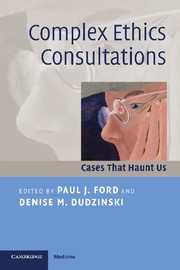Book contents
- Frontmatter
- Contents
- List of contributors
- Foreword
- Acknowledgments
- Introduction: Live and learn: courage, honesty, and vulnerability
- Part I Starting at the beginning: prenatal and neonatal issues
- Part II The most vulnerable of us: pediatrics
- Part III Diversity of desires and limits of liberty: psychiatric and psychological issues
- 9 Helping staff help a “hateful” patient: the case of TJ
- 10 Ulysses contract
- 11 Misjudging needs: a messy spiral of complexity
- 12 When the patient refuses to eat
- Part IV Withholding therapy with a twist
- Part V The unspeakable/unassailable: religious and cultural beliefs
- Part VI Human guinea pigs and miracles: clinical innovations and unorthodox treatment
- Part VII The big picture: organizational issues
- Conclusions, educational activities, and references
- Index
12 - When the patient refuses to eat
Published online by Cambridge University Press: 03 May 2010
- Frontmatter
- Contents
- List of contributors
- Foreword
- Acknowledgments
- Introduction: Live and learn: courage, honesty, and vulnerability
- Part I Starting at the beginning: prenatal and neonatal issues
- Part II The most vulnerable of us: pediatrics
- Part III Diversity of desires and limits of liberty: psychiatric and psychological issues
- 9 Helping staff help a “hateful” patient: the case of TJ
- 10 Ulysses contract
- 11 Misjudging needs: a messy spiral of complexity
- 12 When the patient refuses to eat
- Part IV Withholding therapy with a twist
- Part V The unspeakable/unassailable: religious and cultural beliefs
- Part VI Human guinea pigs and miracles: clinical innovations and unorthodox treatment
- Part VII The big picture: organizational issues
- Conclusions, educational activities, and references
- Index
Summary
The fundamental dynamics of this haunting case began long before the late-June day when the patient presented to our hospital for the first time. Perhaps they began when Mrs. Blue, at the age of 18, married a take-charge man she had known since her childhood. More recently, there was a significant day when Mr. Blue found the patient's mother wandering on foot in the slow lane of a busy freeway. Both of these details emerged as the story unfolded.
Case narrative
Mrs. Blue, 55 years of age, presented to our hospital on a summer day after her husband had arranged an appointment with our psychiatric outpatient clinic for eating disorders. The intake coordinator sent the patient to our emergency department after obtaining a history that the patient had not consumed any food and had taken in very little fluids during the last ten days.
Upon examination in the emergency room, Mrs. Blue was found to be volume depleted, with some renal insufficiency, electrolyte disorders, and hypoalbuminemia. She weighed 36.7 kg (81 lbs) and was 157 cm (5 ft) tall, resulting in a body-mass index (BMI) of 14.7. In other words, the patient weighed less than 67% of her expected body weight, indicating severe malnutrition. As a rule, when a person is approximately 60% of expected weight, death occurs. The team from internal medicine noted that she was alert, oriented, and in no apparent distress.
In late October of the previous year, this patient developed moderately severe headaches and visited her physician. Her husband reported that she had never had any serious illnesses. Breast augmentation surgery was the only surgical procedure she had undergone.
- Type
- Chapter
- Information
- Complex Ethics ConsultationsCases that Haunt Us, pp. 95 - 102Publisher: Cambridge University PressPrint publication year: 2008



